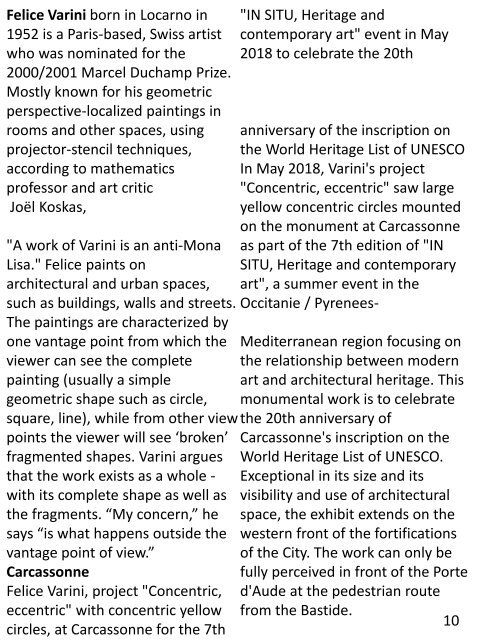Aziz Art October 2018
History of art(west and Iranian)-contemporary art
History of art(west and Iranian)-contemporary art
Create successful ePaper yourself
Turn your PDF publications into a flip-book with our unique Google optimized e-Paper software.
Felice Varini born in Locarno in<br />
1952 is a Paris-based, Swiss artist<br />
who was nominated for the<br />
2000/2001 Marcel Duchamp Prize.<br />
Mostly known for his geometric<br />
perspective-localized paintings in<br />
rooms and other spaces, using<br />
projector-stencil techniques,<br />
according to mathematics<br />
professor and art critic<br />
Joël Koskas,<br />
"A work of Varini is an anti-Mona<br />
Lisa." Felice paints on<br />
architectural and urban spaces,<br />
such as buildings, walls and streets.<br />
The paintings are characterized by<br />
one vantage point from which the<br />
viewer can see the complete<br />
painting (usually a simple<br />
geometric shape such as circle,<br />
square, line), while from other view<br />
points the viewer will see ‘broken’<br />
fragmented shapes. Varini argues<br />
that the work exists as a whole -<br />
with its complete shape as well as<br />
the fragments. “My concern,” he<br />
says “is what happens outside the<br />
vantage point of view.”<br />
Carcassonne<br />
Felice Varini, project "Concentric,<br />
eccentric" with concentric yellow<br />
circles, at Carcassonne for the 7th<br />
"IN SITU, Heritage and<br />
contemporary art" event in May<br />
<strong>2018</strong> to celebrate the 20th<br />
anniversary of the inscription on<br />
the World Heritage List of UNESCO<br />
In May <strong>2018</strong>, Varini's project<br />
"Concentric, eccentric" saw large<br />
yellow concentric circles mounted<br />
on the monument at Carcassonne<br />
as part of the 7th edition of "IN<br />
SITU, Heritage and contemporary<br />
art", a summer event in the<br />
Occitanie / Pyrenees-<br />
Mediterranean region focusing on<br />
the relationship between modern<br />
art and architectural heritage. This<br />
monumental work is to celebrate<br />
the 20th anniversary of<br />
Carcassonne's inscription on the<br />
World Heritage List of UNESCO.<br />
Exceptional in its size and its<br />
visibility and use of architectural<br />
space, the exhibit extends on the<br />
western front of the fortifications<br />
of the City. The work can only be<br />
fully perceived in front of the Porte<br />
d'Aude at the pedestrian route<br />
from the Bastide.<br />
10

















